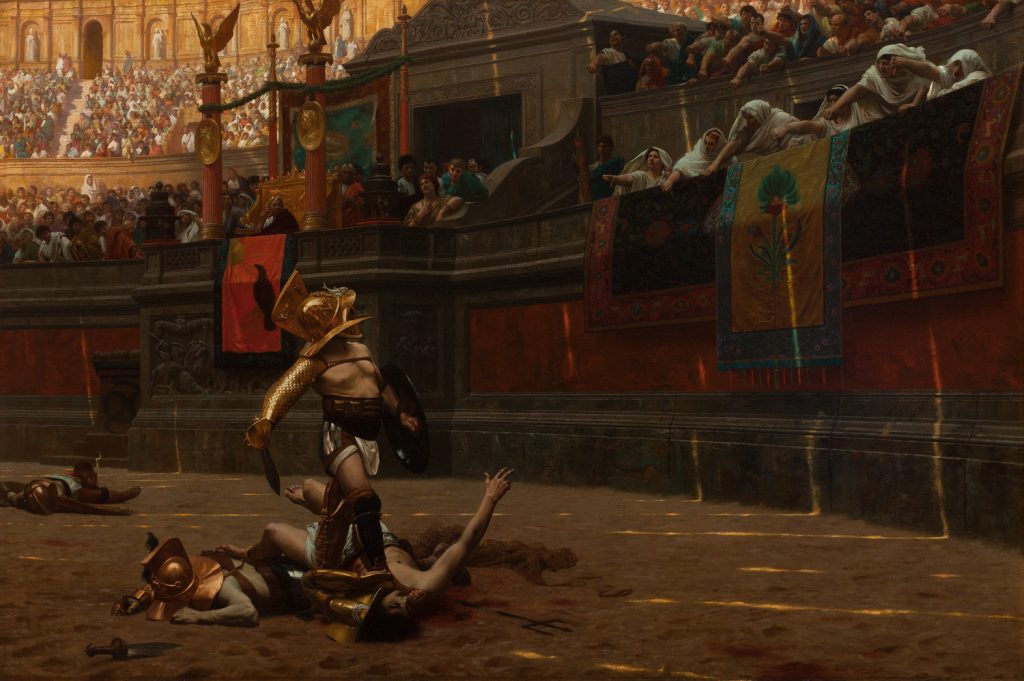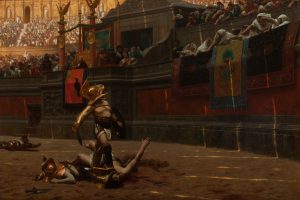Pollice Verso

Aug, 28, 2024
ArtArtists
Pollice Verso

Pollice Verso, a Latin phrase meaning “with a turned thumb,” is the title of Jean-Léon Gérôme’s masterful work, depicting a gladiator duel in the heart of the Roman Coliseum. Gérôme, a renowned artist known for his historical narrative paintings, started this painting before 1869 but temporarily stopped working on it during the Franco-Prussian War. He would go on to finish the work in 1872.
Gérôme’s Pollice Verso is all about the power of gesture and high drama. In Ancient Rome, gladiatorial games were both a form of entertainment for the masses and a form of capital punishment. Gladiators were typically enslaved people, convicted criminals, or prisoners of war who were forced to train and become skilled fighters. In the foreground of Gérôme’s painting, we witness the ending of a gladiator duel, where the victorious gladiator has slayed two fellow fighters and has his foot on the throat of the last person alive. He looks up toward the crowd or perhaps the Roman emperor himself for permission to finish the fight and execute the fellow gladiator.
Perhaps to signal for mercy from the crowd and the emperor, the man on the ground gestures upward with two fingers, reminiscent of the same gesture that is often featured in Catholic iconography during the Byzantine and Renaissance periods. The crowd appears to be booing and putting their thumbs down.
While a modern read on this gesture suggests that a “thumbs down” was a signal that a defeated gladiator should be condemned to death (likely influenced by Ridley Scott’s feature film Gladiator), there are no historical records that confirm this. Because pollice verso simply means with “a turned thumb” (specifying neither up nor down), we do not have a clear answer.
What we do know, however, is that in Gérôme’s painting, we enter the scene during a moment of high suspense, when the emperor has not given a definitive signal either way. Will the defeated gladiator live or die? It is left to the viewer to complete the story for themself.
Gérôme showed a Pollice Verso at a private Salon in 1873, after which the painting was turned into a series of prints and would be used as a reference for his full-scale sculptural work The Gladiators (1873). The work was acquired by PhxArt in 1968 and has been a jewel of the collection and a favorite of visitors ever since.
Come see this masterwork of the PhxArt collection, on view now in our European + American galleries. Learn more at: https://phxart.org/exhibition/european-and-latin-american-art/
Image credit: Jean-Léon Gérôme, Pollice Verso (Thumbs Down)1872. Oil on canvas, Museum purchase.
Works cited: Spier, Christine (2010, August 6). Thumbs Up or Thumbs Down? Looking at Gérôme’s “Pollice Verso.” Getty. https://blogs.getty.edu/iris/thumbs-up-or-thumbs-down-looking-at-geromes-pollice-verso/
Hoakley, (2018, July 26). Too Real: the narrative paintings of Jean-Léon Gérôme, 4. THE ECLECTIC LIGHT COMPANY. https://eclecticlight.co/2018/07/26/too-real-the-narrative-paintings-of-jean-leon-gerome-4/
Categories
What can we help you find?
Need further assistance?
Please call Visitor Services at 602.257.1880 or email